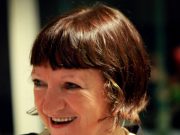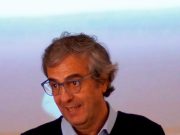
For the English version, please, scroll down.
BERLINO – Il 30 maggio 2019, presso l’HAU1, nell’ambito del Performing Arts Festival di Berlino, ha debuttato Reflection di Isabelle Schad.
Ultima parte della trilogia iniziata nel 2014 con Collective Jump, pezzo sull’utopia di ‘comunità’ come modello sociale, e seguita da Pieces and Elements del 2016, in cui l’individualità dei danzatori era ridotta alla loro sola fisicità, l’ultimo lavoro di Isabelle Schad esplora l’unicità dell’individuo in relazione agli altri.
Quando si apre il sipario, dalla platea un uomo e una donna salgono sulla pedana rotante al centro del palco. Cambiando la direzione di marcia o la velocità dell’andatura, i due camminano fianco a fianco, l’uno di spalle o di fronte all’altra, assecondando o contrastando il verso di rotazione del pavimento. Lentamente, alla prima coppia se ne aggiungono altre finché sul palco non ci sono quattordici performer disposti lungo il perimetro della pedana. Il gruppo moltiplica l’effetto visivo di quel carillon caleidoscopico.
In sottofondo, St. Matthew Passion di Bach è appena udibile.
D’un tratto, uno dei danzatori inizia un movimento che rompe lo schema delle camminate. Immediatamente lo imitano altri performer, mentre in un altro punto del palco, prende vita una differente sequenza che a sua volta viene ripetuta in un canone che finisce soltanto quando sul palco resta soltanto un danzatore e ‘il suo braccio’.
Partendo proprio dalla ‘danza’ di un avambraccio, che quasi diventa un elemento estraneo al resto del corpo, si vanno lentamente formando tre gruppi distinti che, contemporaneamente, eseguono azioni differenti.
I performer passano ciclicamente da uno all’altro gruppo, con ruoli differenti, in un crescendo di velocità.
Seguono alcune immagini molto suggestive in cui i vestiti sembrano essere un’estensione del corpo che supera la sua fisicità proiettandosi oltre la propria finitezza fisica, per poi tornare, nella ciclicità che caratterizza l’intera funzione, alle camminate iniziali che conducono alla fine del pezzo, sempre accompagnato dalla musica di Bach, questa volta, a tutto volume.
Reflection è esattamente l’immagine riflessa e moltiplicata, una concatenazione di causa effetto che si ripete e che, grazie alla ciclicità del movimento, tende all’infinito.

On May 30th 2019, at the HAU1, as part of the Performing Arts Festival in Berlin, Reflection by Isabelle Schad was on.
It is the last part of the trilogy started in 2014 with Collective Jump – a piece about the utopia of ‘community’ as social model -, followed, in 2016, by Pieces and Elements, in which the individuality of the dancers was reduced to their physicality uniqueness, the last work by Isabelle Schad explores the uniqueness of each person in relation to others.
When the curtain opens, a man and a woman get on the rotating platform in the center of the stage. By changing the travel direction or the gait speed, the two walk side by side, backwards , touching one of their shoulders or in front of the other, favouring or contrasting the direction of rotation of the floor. Slowly, the first pair are joined by others until there are fourteen performers on stage. The group multiplies the visual effect of that kaleidoscopic music box.
In the background, St. Matthew Passion by Bach is barely audible.
Suddenly, one of the dancers begins a movement that breaks the pattern of the walks. Immediately other performers imitate him, while, at another point on the stage, a different sequence comes to life, which is repeated in a canon that ends only when just one dancer and “his arm” remain on stage.
Starting right from the “dance” of a forearm, which almost becomes a foreign element to the rest of the body, three distinct groups slowly form and simultaneously perform different actions.
The performers cyclically pass from one to the other group, with different roles, in a crescendo of speed.
It all continues with very suggestive images. Images in which the clothes seem to be an extension of the body that overcomes its physicality projecting itself beyond physical finiteness, to return after, in the cyclical nature that characterises the entire show, to the initial walks that lead to the end of the piece, always accompanied by Bach’s music, this time, at full volume.
Reflection is exactly the reflected and multiplied image, a chain of cause and effect that repeats and that, thanks to the cyclical nature of movement, tends to infinity.
Nicola Campanelli
iscriviti alla newsletter di Campadidanza














































